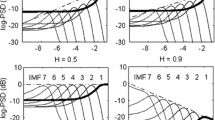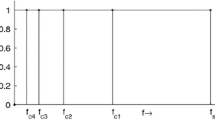Abstract
We present a new method for separation of the rhythms of the electroencephalogram (EEG) signal. The proposed method is based on the Hilbert-Huang transform (HHT). The HHT consists two steps namely empirical mode decomposition (EMD) and the Hilbert transform (HT). The EMD decomposes EEG signal into set of narrow-band intrinsic mode functions (IMFs), and the Hilbert transformation of these IMFs provide instantaneous frequency estimation of the IMFs. The instantaneous frequency estimation of IMFs have been used as a feature to identify the IMFs in order to separate rhythms of EEG signal. The central tendency measure (CTM) has been used to quantify the variability in second order difference (SOD) plots of rhythms of the EEG signal. The CTM parameter is very effective to discriminate epileptic seizure EEG signals from the seizure-free EEG signals. The experimental results show the effectiveness of the proposed method for epileptic seizure detection.
Access this chapter
Tax calculation will be finalised at checkout
Purchases are for personal use only
Preview
Unable to display preview. Download preview PDF.
Similar content being viewed by others
References
Blinowska, K.J., Czerwosz, L.T., Drabik, W., Franaszczuk, P.J., Ekiert, H.: EEG Data Reduction by Means of Autoregressive Representation and Discriminant Analysis Procedures. Electroencephalogr. Clin. Neurophysiol. 51, 650–658 (1981)
Okyere, J.G., Ktonas, P.Y., Meyer, J.S.: Quantification of Alpha EEG Modulation and Its Relation to Cerebral Blood Flow. IEEE Trans. Biomed. Eng. 33, 690–696 (1986)
Pardey, J., Roberts, S., Tarassenko, L.: A Review of Parametric Modeling Techniques for EEG Analysis. Med. Eng. Phys. 18, 2–11 (1996)
Kroemer, K.H.E., Kroemer, H.J., Kroemer-Elbert, K.E.: Engineering Physiology: Bases of Human Factors/Ergonomics. Van Nostrand Reinhold, New York (1990)
Thakor, N.V., Guo, X.R., Sun, Y.C., Hanley, D.F.: Multiresolution Wavelet Analysis of Evoked Potentials. IEEE Trans. Biomed. Eng. 40, 1085–1093 (1993)
Schiff, S.J., Aldroubi, A., Unser, M., Sato, S.: Fast Wavelet Transformation of EEG. Electroencephalogr. Clin. Neurophysiol. 91, 442–455 (1994)
Sircar, P., Pachori, R.B., Kumar, R.: Analysis of Rhythms of EEG Signals using Orthogonal Polynomial Approximation. In: International Conference on Convergence and Hybrid Information Technology, pp. 176–180 (2009)
Zhong, J., Shuren, Q., Chenglin, P.: Study on Separation for the Frequency Bands of EEG Signal and Frequency Band Relative Intensity Analysis Based upon EMD. In: 7th WSEAS International Conference on Signal Processing, Robotics and Automation, University of Cambridge, UK, February 20-22, pp. 151–155 (2008)
Iasemidis, L.D., Shiau, D.S., Chaovalitwongse, W., Sackellares, J.C., Pardalos, P.N., Principe, J.C., Carney, P.R., Prasad, A., Veeramani, B., Tsakalis, K.: Adaptive Epileptic Seizure Prediction System. IEEE Trans. Biomed. Eng. 50, 616–627 (2003)
Boashash, B., Mesbah, M., Colditz, P.: Time Frequency Detection of EEG Abnormalities. In: Boashash, B. (ed.) Time-Frequency Signal Analysis and Processing: A Comprehensive Reference, ch. 15, article 15.5, pp. 663–670. Elsevier (2003)
Pachori, R.B., Sircar, P.: EEG Signal Analysis using FB Expansion and Second-Order Linear TVAR Process. Signal Process. 88, 415–420 (2008)
Adeli, H., Zhou, Z., Dadmehr, N.: Analysis of EEG Records in an Epileptic Patient using Wavelet Transform. J. Neurosci. Methods 123, 69–87 (2003)
Tzallas, A.T., Tsipouras, M.G., Fotisdis, D.I.: Automatic Seizure Detection based on Time-Frequency Analysis and Artificial Neural Networks. Comput. Intell. Neurosci., Article ID 80510 (2007)
Güler, N.F., Übeyli, E.D., Güler, Í.: Recurrent Neural Networks Employing Lyapunov Exponents for EEG Signal Classification. Expert Syst. Appl. 29, 506–514 (2005)
Accardo, A., Affinito, M., Carrozzi, M., Bouquet, F.: Use of the Fractal Dimension for the Analysis of Electroencephalographic Time Series. Biol. Cybern. 77, 339–350 (1997)
Kannathala, N., Choo, M.L., Acharya, U.R., Sadasivan, P.K.: Entropies for Detection of Epilepsy in EEG. Comput. Methods Progr. Biomed. 80, 187–194 (2005)
Ocak, H.: Automatic Detection of Epileptic Seizures in EEG using Discrete Wavelet Transform and Approximate Entropy. Expert Syst. Appl. 36, 2027–2036 (2009)
Pachori, R.B.: Discrimination between Ictal and Seizure-Free EEG Signals using Empirical Mode Decomposition. Res. Lett. Signal Process., Article ID 293056 (2008)
Pachori, R.B., Bajaj, V.: Analysis of Normal and Epileptic Seizure EEG Signals using Empirical Mode Decomposition. Comput. Methods Progr. Biomed. 104, 373–381 (2011)
Bajaj, V., Pachori, R.B.: Classification of Seizure and Nonseizure EEG Signals using Empirical Mode Decomposition. IEEE Trans. Inf. Technol. Biomed. (in press, 2012)
Bajaj, V., Pachori, R.B.: EEG Signal Classification Using Empirical Mode Decomposition and Support Vector Machine. In: Deep, K., Nagar, A., Pant, M., Bansal, J.C. (eds.) Proceedings of the International Conf. on SocProS 2011. AISC, vol. 131, pp. 623–635. Springer, Heidelberg (2012)
Huang, N.E., Shen, Z., Long, S.R., Wu, M.C., Shih, H.H., Zheng, Q., Yen, N.C., Tung, C.C., Liu, H.H.: The Empirical Mode Decomposition and Hilbert Spectrum for Nonlinear and Non-stationary Time Series Analysis. Proc. R. Soc. London A 454, 903–995 (1998)
Flandrin, P., Rilling, G., Goncalvés, P.: Empirical Mode Decomposition as a Filter Bank. IEEE Signal Process. Lett. 11, 112–114 (2004)
Pachori, R.B., Hewson, D., Snoussi, H., Duchêne, J.: Postural Time-Series Analysis using Empirical Mode Decomposition and Second-Order Difference Plots. In: IEEE International Conference on Acoustics, Speech, and Signal Processing, April 19-24, pp. 537–540 (2009)
Cohen, M.E., Hudson, D.L., Deedwania, P.Ć.: Applying Continuous Chaotic Modeling to Cardic Signal Analysis. IEEE Eng. Med. Biol. Mag. 15, 97–102 (1996)
Andrzejak, R.G., Lehnertz, K., Mormann, F., Rieke, C., David, P., Elger C.E.: Indications of Nonlinear Deterministic and Finite-Dimensional Structures in Time Series of Brain Electrical Activity Dependence on Recording Region and Brain State. Phys. Rev. E. 64, Article ID 061907 (2001)
Author information
Authors and Affiliations
Editor information
Editors and Affiliations
Rights and permissions
Copyright information
© 2012 Springer-Verlag Berlin Heidelberg
About this paper
Cite this paper
Bajaj, V., Pachori, R.B. (2012). Separation of Rhythms of EEG Signals Based on Hilbert-Huang Transformation with Application to Seizure Detection. In: Lee, G., Howard, D., Kang, J.J., Ślęzak, D. (eds) Convergence and Hybrid Information Technology. ICHIT 2012. Lecture Notes in Computer Science, vol 7425. Springer, Berlin, Heidelberg. https://doi.org/10.1007/978-3-642-32645-5_62
Download citation
DOI: https://doi.org/10.1007/978-3-642-32645-5_62
Publisher Name: Springer, Berlin, Heidelberg
Print ISBN: 978-3-642-32644-8
Online ISBN: 978-3-642-32645-5
eBook Packages: Computer ScienceComputer Science (R0)




